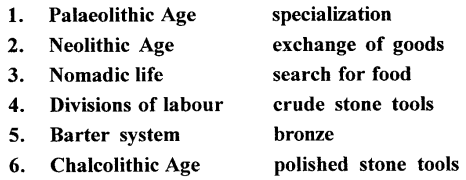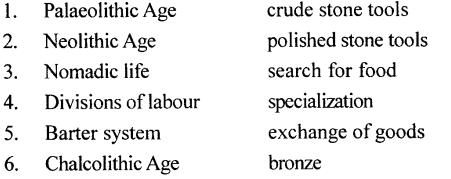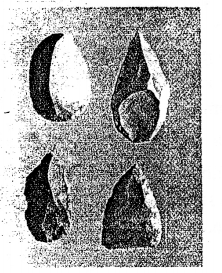ICSE Solutions for Class 6 History and Civics – History – Early Man
ICSE SolutionsSelina ICSE SolutionsML Aggarwal Solutions
APlusTopper.com provides step by step solutions for ICSE Solutions for Class 6 History and Civics Chapter 2 Early Man . You can download the History and Civics ICSE Solutions for Class 6 with Free PDF download option. History and Civics for Class 6 ICSE Solutions all questions are solved and explained by expert teachers as per ICSE board guidelines.
ICSE Solutions Class 6 History & Civics Geography Biology Chemistry Physics Maths
Exercise
I. Fill in the blanks:
- The system of exchanging things is known as Barter.
- Early man was a Nomad, but later he led a settled life.
- Instead of killing Animals man domesticated them and used them as means of transport.
- Man started worshiping Natural forces/gods out of fear.
II. Write True or False against the following statements:
- The Old Stone Age lasted from 100,000 BC to 8,000
False. - Early Man always lived close to rivers.
True. - The discovery of fire was a pure coincidence.
True. - Fire helped man in making better tools.
False. - Man started making shorter and tinier tools called ‘Microliths’ in the Neolithic Age.
False. - The New Stone Age is known for discovery of agriculture and invention of wheel.
True. - The invention of the wheel made transportation easier and faster.
True. - Primitive men believed in life after death.
True.
III. Answer the following questions briefly:
Question 1.
When did modern man appear on the earth?
Answer:
The modem man appeared on the earth around 40,000 years ago.
Question 2.
Name the three periods of the prehistoric time.
Answer:
Three periods of prehistory — palaeolithic age, mesolithic age and neolithic age.
Question 3.
How did early man dress himself in the Stone Age?
Answer:
During the Stone Age early man wore animal skins, bark of trees and leaves.
Question 4.
Which discoveries changed the life of Early Man ?
Ans.
The discovery of fire and agriculture changed the life of early man. Later on he started making pottery. Invention of wheel also transformed the life of early man.
Question 5.
How were the tools of the New Stone Age different from those of the Old Stone Age ?
Answer:
During the Old Stone Age stone tools were crude, big and blunt. They were used for different purposes such as cutting trees, killing and skinning animals, chopping meat, etc. During the New Stone Age, tools became smaller, sharper, pointed and fine-shaped. They were used as spears, arrow heads, etc.
Question 6.
Describe the main features of the Neolithic Age ?
Answer:
During the Neolithic Age man least to make better tools grow food crops and domesticate animals. This age remarkable for discovery of agriculture, fine pottery and invention of wheel. Man became a food-producer and began leading a settled life.
Question 7.
How did the invention of wheel change the life of early man?
Answer:
The invention of wheel brought many changes in the life of man. Early man made wheeled-cart which made transportation easier and faster. Potters made fine pottery of various shapes and sizes quickly on wheels. Later the wheel was also used for spinning and weaving cloth of cotton.
Question 8.
Trace the development of early man from being a food gatherer to a food producer.
Answer:
During the Palaeolithic Age, early man was a food gatherer. He wandered from place to place in search of food. He hunted wild animals for their meat which they ate raw. With discovery of fire, he learnt to roast meat. During the Neolithic Age early man began to grow food crops. He became a food-producer. Hence, he settled at one place, began domestication of useful animals and stored grains for future use in pots.
Textbook Keywords
- Palaeolithic Age:It is the Old Stone Age in which humans made crude stone tools. It extended roughly from 500, 000 BCE to 10, 000 BCE.
- Mesolithic Age: It is the Middle Stone Age which was a transition period. It extended roughly from 10, 000 BCE to 8,000 BCE.
- Neolithic Age: It is the New stone Age in which human made well shaped and polished stone tools. It extended roughly from 8,000 BCE to 4,000 BCE.
- Barter System: It is the system of exchanging services and goods.
- Chalcolithic Age: It is the Copper-stone Age in which humans made tools of both copper and stone. It extended roughly from 4, 000 BCE to 2, 000 BCE.
- Bronze: It is the alloy of copper and tin. It is harder and stronger than copper.
Additional Questions
A. Fill in the blanks.
- 1. In the earliest stages of physical development, humans walked on all four.
- In earliest times humans lived in caves and other natural shelters.
- The Old Stone Age humans made stone tools such as hammers, scrapers and axe-heads
- Early humans did not know how to grow crops. They were hunters and food gatherers
- To protect themselves from wild animals early humans began to form small groups.
- Primitive humans painted pictures of animals and hunting scenes on cave walls.
- The greatest achievement of early humans was the discovery of fire
- The stone tools of the Neolithic Age were well-shaped and polished.
- Neolithic humans domesticated dogs, goats, sheep and cattle.
- The invention of the wheel was a major milestone in the evolution of the civilized human.
- The system of exchanging services and goods is known as the Barter system.
- Copper and stone tools were used during the Chalcolithic Age.
B. Match the following
A B

Answer:

C. Answer the following questions.
Question 1.
Describe the life of prehistoric humans in the earliest times.
Answer:
In earliest times, prehistoric humans lived alone in caves or other natural shelters. They ate wild berries, roots, fruits, insects, worms and flesh of small animals. They used their bare hands to kill small animals. They did not wear any clothes and their bodies were covered with thick hair.
Question 2.
Name the periods into which the Stone Ages can be broadly divided.
Answer:
The Stone Age can be broadly divided into four periods. They are following.
- Palaeolithic Age or Old Stone Age
- Mesolithic Age or Middle Stone Age
- Neolithic Age or New Stone Age
- Chalcolithic Age or Copper Stone Age
Question 3.
Describe the tools made by humans in the Palaeolithic Age. What purposes did these tools serve?
Answer:
During the Palaeolithic Age mao made crude unpolished tools. They shaped the large stone pieces into, hammers, scrapers and axe-heads. The purposes of these tools were for cutting tree, killing and skinning animals, chopping meat and digging up roots.
Question 4.
What did the people of the Old Stone Age eat?
Answer:
The people of Old Stone Age did not know how to grow crops. Their food consisted of fruits, roots, nuts, eggs of birds and raw flesh of animals and birds.
Question 5.
Where did early humans live? What did they wear?
Answer:
Early humans lived in caves and hide himself among the branches of trees. Early human did not wear clothes, But later they make clothes by stitching animal skins with bone needles.
Question 6.
How do we know that early humans were skillful artists?
Answer:
There is no doubt that early humans were skillful artist because the painted pictures of animals and drawn hunting scenes with great accuracy and skill on cave walls. They also engraved pictures on ivory horns and flat bones.
Question 7.
How did early humans discover fire? How did this discovery help them?
Answer:
Early humans found that when two dry stones rubbed together produce sparks of fire. This discovery bought a great change in their life. They used it for roasting food, lighting his cave, keeping warm in cold season and frightening animals.
Question 8.
What important changes took place in the life style of humans in the New Stone Age?
Answer:
In the New Stone Age human became a food produces from food gatherer. He gave up his cave and made huts of straw and mud and he also made better well grooved and more useful tools.
Question 9.
Discuss two important occupations of humans in the New Stone Age.
Answer:
Agriculture and domestication of animals were two important occupations of humans in the New Stone Age.
Question 10.
How did the invention of the wheel transform the life of the people in the Neolithic Age?
Answer:
The discovery of the wheel was an important achievement of the man in the Neolithic Period.It brought a rapid progress in making beautiful pots. The wheel was used in horse-carts and bullock-carts. Which made transport quite easy and quick. The wheel was used for carrying loads and also used for spinning and weaving. In this way the invention of the wheel was a major achievement of man in his march towards civilization.
Question 11.
Why did early humans make pots? How did the invention of the potter’s wheel affect the art of pottery making?
Answer:
Early humans make pots because they needed pots to store grains, water and food. The invention of the potter’s wheel was boon for potters. They made pots of various shapes and sizes, pots were often decorated with floral designs and geometrical patterns.
Question 12.
‘Agriculture and domestication of animals brought dramatic changes in the of humans’. Explain.
Answer:
Agriculture— The discovery of Agriculture has a great importance in the life of humans. The man now become a food producer instead of a food-gatherer and thus, he began to lead a settled life. He now grow com, vegetables and fruits near his hut.
Domestication— The Domestication of animals help the humans in many ways Dogs, goats, sheep and cattle were domesticated. These animals supplied milk, meat and skins. Bullocks, donkeys and horses were later used to plough the fields. In these ways agriculture and domestication brought dramatic changes in the life of humans.
Question 13.
Write short notes on the following:
1. The barter system
2.Social life during the Neolithic Age
Answer:
- The barter system It is the system of exchanging services and goods. For example, the potters got food grains in exchange for pots and vice versa.
- Social life during the Neolithic Age From the earliest times, people had been living in groups. It became necessary to have a code of conduct to regulate and control the activities of the people. These rules became established customs. The oldest, wiser or the strongest man in the village was chosen as the village head man. He maintained law and order in the village and protected the people from enemies.
Question 14.
Mention the chief features of the Chalcolithic Age.
Answer:
Chalcolithic Age is known as the Copper-Stone Age. It was a brief but significant period in the life of man. The main features of the Chalcolithic Age were following.
- In Chalcolithic Age discovery of metals and improved implements led to the development of agricultural skills to a high degree.
- Chalcolithic Settlements were rural in nature Society became more complex and was classified into different groups.
D. State whether the following are true or false.
- The humans of the Old Stone Age were hunters and food gatherers.
True. - Fire was discovered in the Neolithic Age.
False. - The Neolithic humans used digging sticks and stone sickles.
True.
- Humans did not know spinning and weaving in the New Stone Age.
False
- Copper is harder and stronger than bronze.
False.
E. Picture study.
The picture below shows some stone implements.

- To which prehistoric age do these implements belong?
Ans. These implements belongs to Neolithic Age. - How are these implements different from those belonging to the previous age?
Ans. These implements were beautiful, well grooved and more useful than belonging to the previous age. - What purpose did these tools serve?
Ans. Humans used these tools to till the soil and to reap the crops. - Mention five important changes that took place in the lifestyle of humans of this period.
Ans.
1. In Neolithic age man became a food producer from food gatherer.
2.Man gave up his cave and made huts of straw and mud near his fields.
3.Man made better, beautiful well grooved, and more useful tools.
4. The invention of wheel made the life easier and more comfortable.
5. Man began to live in groups and human life became more organized.